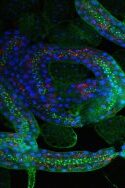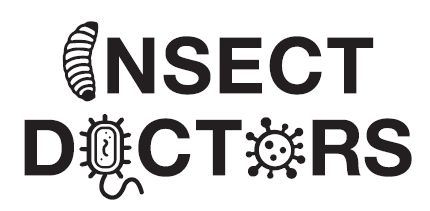WP2 Research Projects:
Covert infections and pathogen detection
Understanding the molecular mechanisms behind latency / persistence (covert infections)
and how to discover / detect pathogens to prevent disease outbreaks.
Project 6
Molecular mechanisms behind maintenance of covert DNA virus infections in Lepidoptera

PhD candidate
Melissa Lloyd
Supervisors
- Vera Ros and Monique van Oers, Wageningen University (NL)
- Salvador Herrero,
University of Valencia (ES)
Outline
Covert virus infections allow for viral persistence without killing the host. These infections result in a major reduction in viral loads relative to overt infections. Covert infections are transmitted vertically from parent to offspring, and are only produced in viruses that are capable of adopting an infection strategy that is less virulent to the host as reproduction is required. The fitness costs of infection on the host need to be as little as possible to ensure host survival and reproduction. Covert baculovirus infections in mass-reared Lepidoptera are ticking bombs, causing few or no symptoms until triggered into an overt lytic state when the host is stressed. In order to manage or remove covert infections from mass-reared populations, the mechanisms involved in establishing and maintaining covert infections need to be elucidated.
The main aim of this project is to unravel the molecular mechanisms underlying maintenance of covert virus infections in insect hosts and to determine the impact of such infections on host fitness and immunity. The interaction between the specialist baculovirus SeMNPV and its host Spodoptera exigua will be used as a model host-viral system. Establishing the mechanism in baculoviruses can lead to further investigations into other virus families to see whether homologous mechanisms exist.
In my project I will focus in understanding the potential role of the RNA interference (RNAi) pathway as determinant of the covert infection. The RNAi response in insects is the primary defence against RNA virus challenge, as well as playing an important role in defence against DNA viruses. Small non-coding RNAs (snRNAs) form the primary components of the RNAi pathway, including short interfering RNAs (siRNAs), piwi-interacting RNAs (piRNAs), and microRNAs (miRNAs). The miRNA pathway is an important factor mediating host-pathogen interactions, and may be involved in establishment and maintenance of covert infections. Viruses have been found to produce miRNAs which play a pivotal role in host-virus interactions, particularly in hi-jacking the host’s immune response to aid viral replication.
Project 7
Tsetse fly associated covert viruses and endosymbionts
Insect pests such as tsetse flies cause major health and economic problems as they transmit trypanosomes causing sleeping sickness in humans and nagana in animals (cattle, antelopes). The Sterile Insect Technique (SIT) is an effective method of vector control. It consists of sterilizing the males by irradiation. Then a large number of sterile males are released in the target area. The sterile males compete with wild males to mate with virgin females. Females mate only once, and those that mate with a sterile male produce no offspring, reducing the population size of the next generation. In order to have success with the SIT, it is important to have a healthy and competitive insect colony. The aim of this project is to improve tsetse mass rearing by analysing the impact of viral infection on colony performance.

PhD candidate
Hannah Isadora Huditz
Supervisors
- Monique van Oers, Wageningen University (NL)
- Ben Raymond, University of Exeter (UK)
- Adly Abt Alla, IAEA / FAO (AT)

Outline
The problem in insect’s mass production are often covered viruses such as the Glossina pallidipes salivary gland hypertrophy virus (GpSGHV) for Glossina pallidipes which can cause the collapse of an entire colony. Recently, two new covert viruses have been detected in Glossina moristans morsitans: Iflavirus and Negevirus. Up to now, effects of these two viruses on colony performances are unknown. Previous results show that Ifla- and Negevirus are present in all Glossina species held in the rearing facility of Seibersdorf (Austria), except in Glossina pallidipes. On the other hand, G. pallidipes is the only species suffering from the negative effects of GpSGHV. This evokes that Ifla-and Negevirus might protect the other tsetse species from SGHV. My project aims to get a deeper insight on the mode of transmission and tissue tropism of these new viruses. In order to do so, we preformed stellaris Insitu hybridization as well as qPCR to detect the localization and level of virus expression in different tsetse fly tissues. The next step will be to infect Glossina pallidipes with the Ifla and Negevirus. The goal will be to understand impact of Ifla and Negevirus on the colony, their transmission pathways as well as a possible protective effect against SGHV in G. pallidipes. Another interesting point will be to study the virus gene expression profiles under covert (asymptomatic) and overt (symptomatic) infections.
Finally, we will study the interaction of the identified viruses with the tsetse flies’ endosymbionts, as these might help to control viral infections. A further point will be to determine whether the virus status affects the vector competence for trypanosomes.
Project 8
Covert infections with RNA viruses in the Mediterranean fruit fly
Every year, fruit pests including medfly cause serious economic losses worldwide in the agriculture industry. Medflies are mainly counteracted using biological control strategies which require the production of tons of insects with specific characteristics. Unravelling the mechanisms underlying the RNA covert infections in medflies can potentially increase profitability and production capacity of the industry by reducing risks associated with the presence of viral pathogens.

PhD candidate
Supervisors
- Salvador Herrero, University of Valencia (ES)
- Vera Ros, and Monique van Oers, Wageningen University (NL)
Outline
Covert infections with RNA viruses have been detected in mass-reared medflies and can compromise the success of biological control strategies by a) causing colony collapse on mass-rearing facilities or b) causing detrimental fitness traits on infected flies. Unravelling the mechanisms underlying RNA covert infections in medflies can potentially increase the profitability and production capacity of the industry by reducing risks associated with the presence of pathogens and may increase the mating capacity of the released sterile males.
In this context, I will explore the RNA virome of medfly using Next Generation Sequencing data and bioinformatics approaches. I will also characterize the interaction between RNA viruses and medfly host, with a special interest in fitness traits derived from the presence of covert infections, the molecular mechanism behind covert infections, and the immune response triggered in the host. Finally, I will explore whether the parasitism behaviour of Diachasmimorpha longicaudata, a natural enemy of medfly, is altered by the presence of RNA covert viral infections.
During my Ph.D. project, I will focus on covert infections caused by RNA viruses in Ceratitis capitata, also known as the Mediterranean fruit fly or medfly. Medfly is a worldwide agricultural pest. Biological control strategies to counteract this pest include the sterile insect technique (SIT; releasing large numbers of sterile males into the field) or the delivery of natural parasitoids of the flies into the field. These strategies rely on the production of tons of insects with specific characteristics, generated by the insect mass-rearing industry.
Apart from purely scientific objectives, I aim to convince family and friends that working with insects is worth it and is more relevant for our lives than we could think! Insects are agricultural pests and vectors of disease but also important decomposers, pollinators, and so on.
Project 9
Virus discovery in reared insects
Black soldier flies (Hermetia illucens, BSF) are a marvel for the up-and-coming insect rearing industry. They are robust and can grow really big. They even produce their own antimicrobial peptides! However, diseases and disorders are becoming more noticeable in BSF. So, we need to find out which pathogens are responsible for these collections of symptoms and colony collapses.

PhD candidate
Robert Pienaar
Supervisors
Elisabeth Herniou IRBI / CNRS (FR)
- Salvador Herrero, University of Valencia (ES)

Outline
Just like with humans and new viruses such as SARS-CoV-2 (COVID-19), mass-reared insects can also face new viral threats, as well as old ones. The trick is to be able to identify viruses rapidly, and to improve our knowledge of the viruses that are out there. Even if there is no visible threat at a certain point in time, there is a need for ways to easily detect covert viral infections, or viral infections which produce no obvious symptoms. This is very relevant for the growth of BSF and their further applications in food and feed industry.
BSF are remarkable insects currently utilized in the mass-rearing industry. They are resilient and relatively easy to keep happy. Over the last eight years, from not really experiencing any diseases in BSF before, there have been some naturally occurring symptoms and mortalities described more often in BSF colonies. These symptoms (and sometimes mortalities) are not commonly reported in public domains. However, it appears these issues are becoming more prevalent in the BSF mass-rearing industry around the globe, and the causal agents have yet to be identified. In a multi-pronged diagnostic approach taken in relation with the industry, this project aims to establish the virome of BSF and to push forward with the initial steps of diagnostic and preventative management of any viral pathogens which may harass BSF colonies. Metagenomic and metatranscriptomic approaches on both asymptomatic and symptomatic samples will be used to provide an in-depth characterisation of the BSF virome. Only then, will it be possible to explore the symptomology and epidemiology of the pathogens.
Project 10
Development of diagnostics tools for pathogen detection in a variety of mass reared insects
Surveying the prevalence of pathogens in mass-reared insects is essential for preserving insect colonies with significant economic and environmental impacts. A combination of Next Generation Sequencing technologies and metagenomics may provide an effective solution for producing a rapid, on-site diagnostic tool with potential application to different insect models.
Outline
The goal of this project is to develop a diagnostic tool for the early detection of pathogens in mass reared insects. We are aiming to deploy a customizable tool, able to work on-site at rearing facilities and flexible enough to be used in different insect models. This will be achieved by using a metagenomics targeting approach using the latest sequencing technologies. One tool of choice is the pocket-sized portable MinION sequencer (Oxford Nanopore Technologies, Oxford, UK) that is easily accessible at a low start-up cost and has proven promising for pathogen surveillance in humans and plants. Having a portable and easy to run on-site diagnostic tool will be useful for periodic monitoring of pathogens in insect mass-rearing facilities to detect early infections before disease onset. We will evaluate the use of this technology in multiple mass-reared insect models of agricultural importance, including the codling moth (Cydia pomonella) and the Western honeybee (Apis mellifera).
The metagenomic sequencing and the pipeline for analysis: the sampling strategy, nucleic acid preparation, sequencing workflow and the actual bioinformatics analysis for diagnostics, will be established. A database containing available sequences of insect pathogens will be constructed from public repositories. The output will be a customizable database for each insect model that will function as the reference in the bioinformatics pipeline in development. Emphasis will be placed on evaluating the overall quality of the sequence data, generated from MinION sequencing of test specimens, as well as the sensitivity and accuracy of the bioinformatics analyses to carried out for diagnostics. This will be achieved by initial in silico testing of the pipeline using sequences from artificially created microbial communities, followed by further evaluation using insect colonies from mass-rearing facilities and from the field. Test specimens will include mock- and naturally infected insects.
The efficiency of the diagnostic tool in development will be compared to that of conventional diagnostic methods, such as quantitative PCR and microscopy. Later, the diagnostic tool will be deployed in the field to determine the presence and prevalence of pathogens affecting C. pomonella, A. mellifera as well as other economically important insects from various mass-rearing facilities and from the wild.



